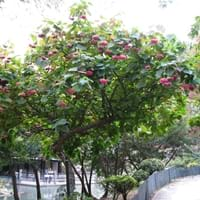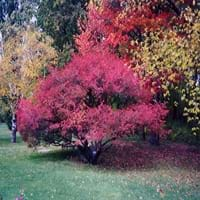Life Span
Perennial
Perennial
Origin
Eastern Africa, Madagascar
Europe, Western Asia
Types
Not Available
Euonymus fortunei, Euonymus alatus, Euonymus europaeus
Habitat
gardens, Screen Cottage and Informal Garden
Dappled Shade, Shady Edge, Sunny Edge, Woodland Garden
USDA Hardiness Zone
9-15
4-7
Sunset Zone
H1, H2, 22, 23, 24
1a, 1b, 2a, 2b, 3a, 3b, 4, 5, 6, 7, 8, 9, 14, 15, 16
Habit
Oval or Rounded
Upright/Erect
Flower Color
Pink, Hot Pink, Magenta, Rose
Yellow green
Flower Color Modifier
Not Available
Not Available
Fruit Color
Not Available
Pink, Purple, Red
Leaf Color in Spring
Green, Light Green
Green
Leaf Color in Summer
Green
Green
Leaf Color in Fall
Green
Red
Leaf Color in Winter
Green
Not Available
Leaf Shape
Cordate
Lanceolate to elliptical
Plant Season
Spring, Winter
Fall
Sunlight
Full Sun, Partial Sun
Full Sun, Partial Sun, Partial shade
Type of Soil
Loam, Sand
Clay, Loam, Sand
The pH of Soil
Acidic, Neutral
Acidic, Neutral, Alkaline
Soil Drainage
Well drained
Well drained
Bloom Time
Early Spring, Spring, Winter, Late Winter
Late Spring
Repeat Bloomer
Not Available
No
Tolerances
Drought
Drought
Where to Plant?
Ground, Pot
Ground, Pot
How to Plant?
Semi-hardwood and hardwood cuttings, Stem Cutting
Cuttings, Seedlings
Plant Maintenance
Medium
Medium
Watering Requirements
Average Water Needs, Do Not over Water, Requires regular watering
Average Water Needs, Do Not over Water
In Summer
Lots of watering
Lots of watering
In Spring
Moderate
Moderate
In Winter
Average Water
Average Water
Soil pH
Acidic, Neutral
Acidic, Neutral, Alkaline
Soil Type
Loam, Sand
Clay, Loam, Sand
Soil Drainage Capacity
Well drained
Well drained
Sun Exposure
Full Sun, Partial Sun
Full Sun, Partial Sun, Partial shade
Pruning
Remove damaged leaves, Remove dead branches, Remove dead leaves
Remove damaged leaves, Remove dead branches, Remove dead leaves
Fertilizers
All-Purpose Liquid Fertilizer
organic fertlizers
Pests and Diseases
Red blotch
Powdery mildew, Vine weevils
Plant Tolerance
Drought
Drought
Flowers
Showy
Insignificant
Flower Petal Number
Not Available
Single
Foliage Texture
Coarse
Medium
Foliage Sheen
Not Available
Glossy
Attracts
Butterflies
Birds
Allergy
Not Available
Mild Allergen
Aesthetic Uses
Cottage Garden, Formal Garden, Showy Purposes
Showy Purposes
Beauty Benefits
Not Available
Not Available
Environmental Uses
Air purification
Air purification
Medicinal Uses
Not Available
Alterative, Laxative, Purgative, Tonic
Part of Plant Used
Flowers
Bark, Seeds, Wood
Other Uses
Dried heads are used in floristry, Grown for shade
Edible yellow dye is obtained, Used as essential oil, Yields a volatile oil that is used in soap making
Used As Indoor Plant
No
Yes
Used As Outdoor Plant
Yes
Yes
Garden Design
Hedges, Mixed Border, Screening, Wind Break, Tropical
Hedges, Screening, Wind Break
Botanical Name
DOMBEYA wallichii
EUONYMUS europaeus 'Aldenhamensis'
Common Name
Pinkball, Pink ball tree, Tropical hydrangea
Spindle Tree, Common Spindle, European Spindle
In Hindi
Pink Ball Tree
Spindle Tree
In German
Pink Ball Tree
Spindelbaum
In French
Pink Ball Tree
Spindle Arbre
In Spanish
Pink Ball Tree
Árbol del husillo
In Greek
Pink Ball Tree
ατράκτου Δέντρο
In Portuguese
Pink Ball Tree
Árvore spindle
In Polish
Dombeja Wallicha
Wrzeciono Drzewo
In Latin
Pink Ball Tree
Ligno colos
Phylum
Tracheophyta
Magnoliophyta
Class
Magnoliopsida
Magnoliopsida
Order
Malvales
Celastrales
Family
Sterculiaceae
Celastraceae
Clade
Angiosperms, Eudicots, Rosids
Angiosperms, Eudicots, Rosids
Tribe
Not Available
Euonymeae
Subfamily
Dombeyoideae
Celastroideae
Number of Species
Not Available
Not Available
Importance of Pink Ball Tree and Spindle Tree
Want to have the most appropriate plant for your garden? You might want to know the importance of Pink Ball Tree and Spindle Tree. Basically, these two plants vary in many aspects. Compare Pink Ball Tree and Spindle Tree as they differ in many characteristics such as their life, care, benefits, facts, etc. Every gardener must at least have the slightest clue about the plants he wants to plant in his garden. Compare their benefits, which differ in many ways like facts and uses. The medicinal use of Pink Ball Tree is Not Available whereas of Spindle Tree is Alterative, Laxative, Purgative and Tonic. Pink Ball Tree has beauty benefits as follows: Not Available while Spindle Tree has beauty benefits as follows: Not Available.
Compare Facts of Pink Ball Tree vs Spindle Tree
How to choose the best garden plant for your garden depending upon its facts? Here garden plant comparison will help you to solve this query. Compare the facts of Pink Ball Tree vs Spindle Tree and know which one to choose. As garden plants have benefits and other uses, allergy is also a major drawback of plants for some people. Allergic reactions of Pink Ball Tree are Not Available whereas of Spindle Tree have Mild Allergen respectively. Having a fruit bearing plant in your garden can be a plus point of your garden. Pink Ball Tree has showy fruits and Spindle Tree has showy fruits. Also Pink Ball Tree is not flowering and Spindle Tree is not flowering . You can compare Pink Ball Tree and Spindle Tree facts and facts of other plants too.





